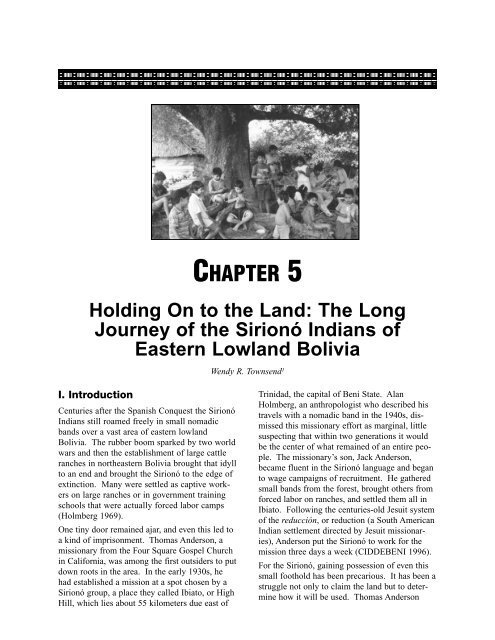Indigenous Peoples and Conservation Organizations
Indigenous Peoples and Conservation Organizations
Indigenous Peoples and Conservation Organizations
Create successful ePaper yourself
Turn your PDF publications into a flip-book with our unique Google optimized e-Paper software.
CHAPTER 5<br />
Holding On to the L<strong>and</strong>: The Long<br />
Journey of the Sirionó Indians of<br />
Eastern Lowl<strong>and</strong> Bolivia<br />
Wendy R. Townsend 1<br />
I. Introduction<br />
Centuries after the Spanish Conquest the Sirionó<br />
Indians still roamed freely in small nomadic<br />
b<strong>and</strong>s over a vast area of eastern lowl<strong>and</strong><br />
Bolivia. The rubber boom sparked by two world<br />
wars <strong>and</strong> then the establishment of large cattle<br />
ranches in northeastern Bolivia brought that idyll<br />
to an end <strong>and</strong> brought the Sirionó to the edge of<br />
extinction. Many were settled as captive workers<br />
on large ranches or in government training<br />
schools that were actually forced labor camps<br />
(Holmberg 1969).<br />
One tiny door remained ajar, <strong>and</strong> even this led to<br />
a kind of imprisonment. Thomas Anderson, a<br />
missionary from the Four Square Gospel Church<br />
in California, was among the first outsiders to put<br />
down roots in the area. In the early 1930s, he<br />
had established a mission at a spot chosen by a<br />
Sirionó group, a place they called Ibiato, or High<br />
Hill, which lies about 55 kilometers due east of<br />
Trinidad, the capital of Beni State. Alan<br />
Holmberg, an anthropologist who described his<br />
travels with a nomadic b<strong>and</strong> in the 1940s, dismissed<br />
this missionary effort as marginal, little<br />
suspecting that within two generations it would<br />
be the center of what remained of an entire people.<br />
The missionary’s son, Jack Anderson,<br />
became fluent in the Sirionó language <strong>and</strong> began<br />
to wage campaigns of recruitment. He gathered<br />
small b<strong>and</strong>s from the forest, brought others from<br />
forced labor on ranches, <strong>and</strong> settled them all in<br />
Ibiato. Following the centuries-old Jesuit system<br />
of the reducción, or reduction (a South American<br />
Indian settlement directed by Jesuit missionaries),<br />
Anderson put the Sirionó to work for the<br />
mission three days a week (CIDDEBENI 1996).<br />
For the Sirionó, gaining possession of even this<br />
small foothold has been precarious. It has been a<br />
struggle not only to claim the l<strong>and</strong> but to determine<br />
how it will be used. Thomas Anderson

















